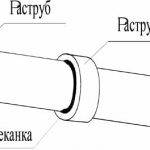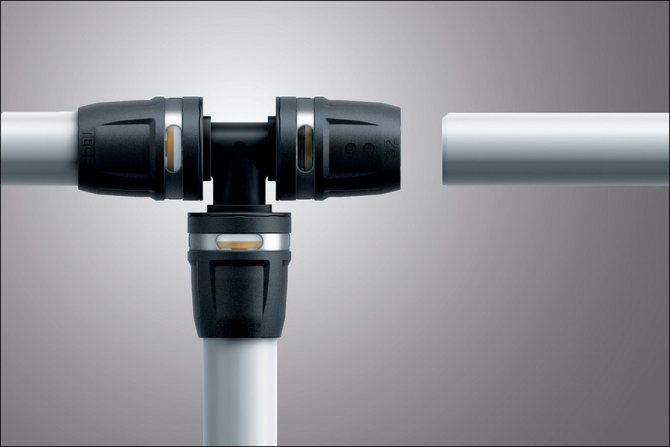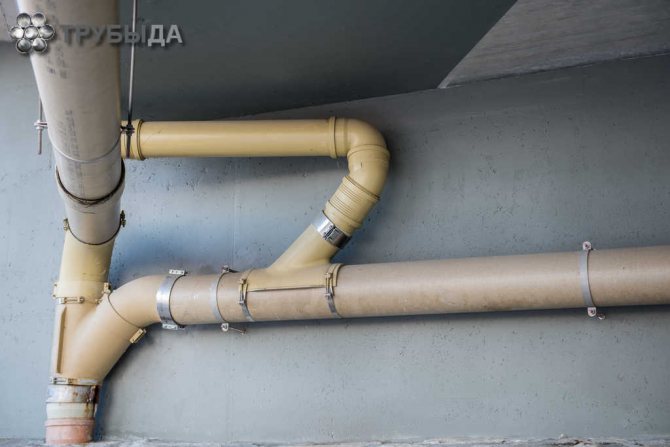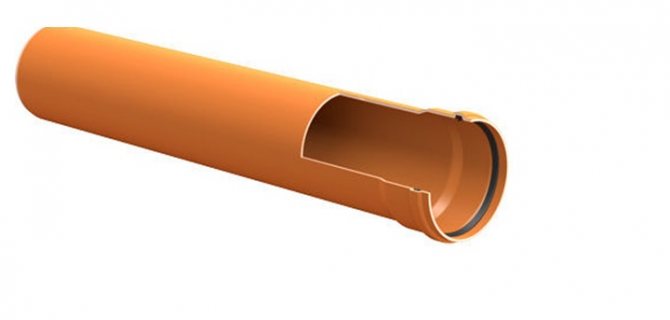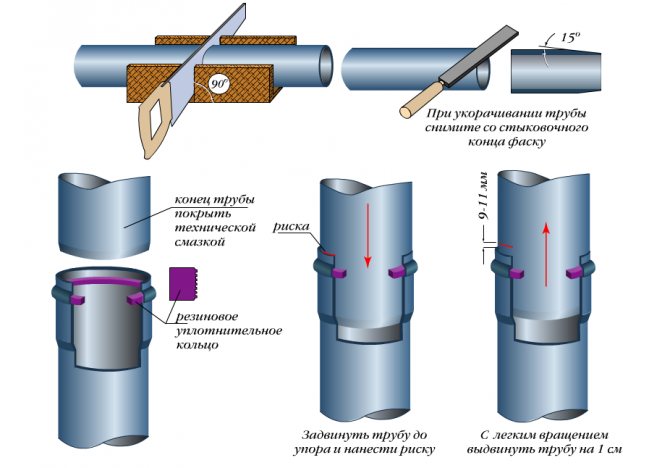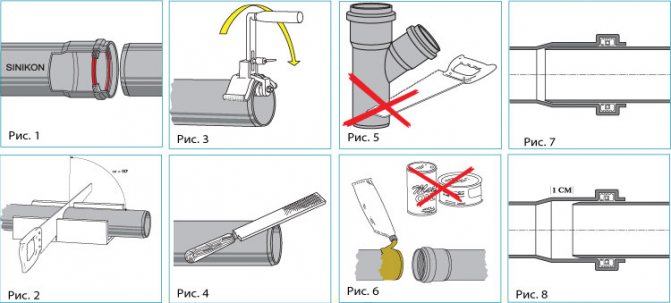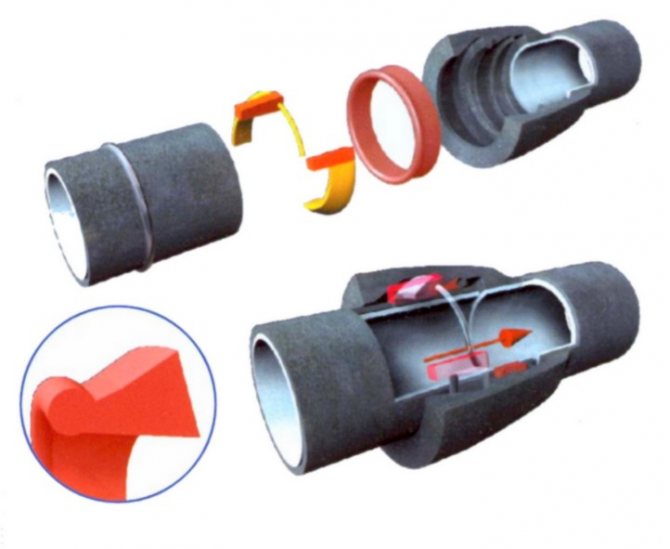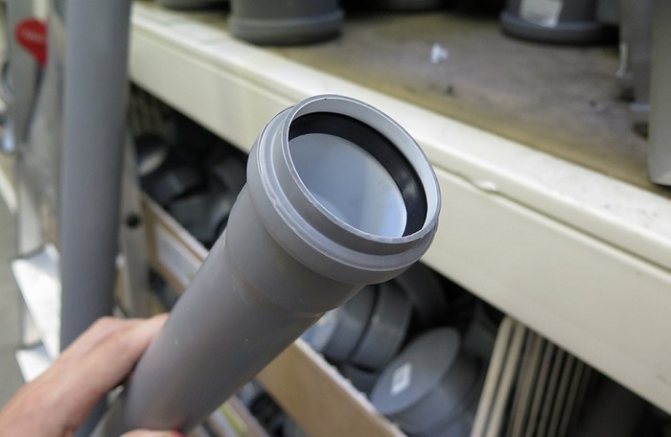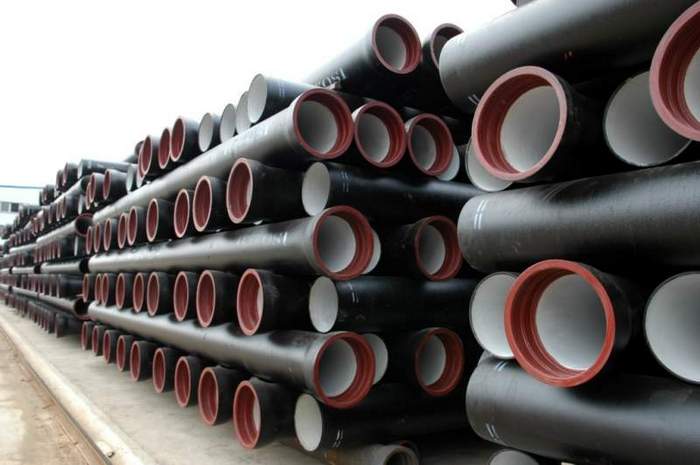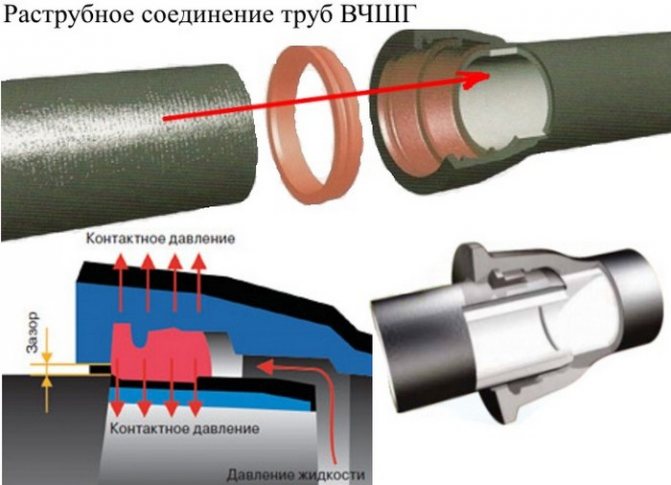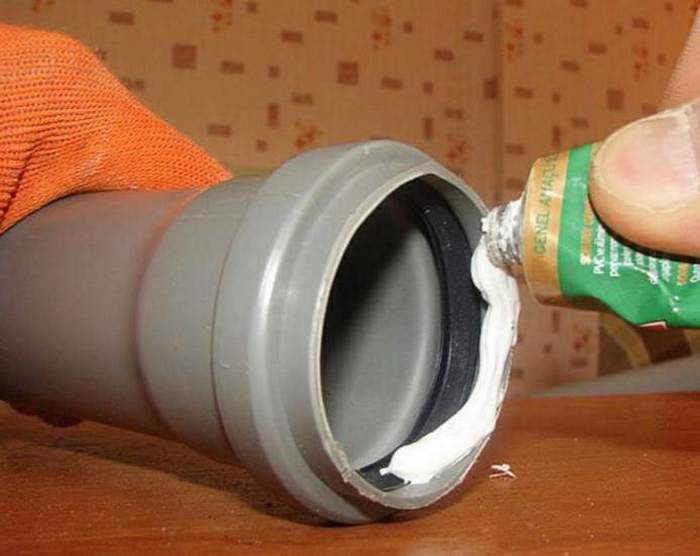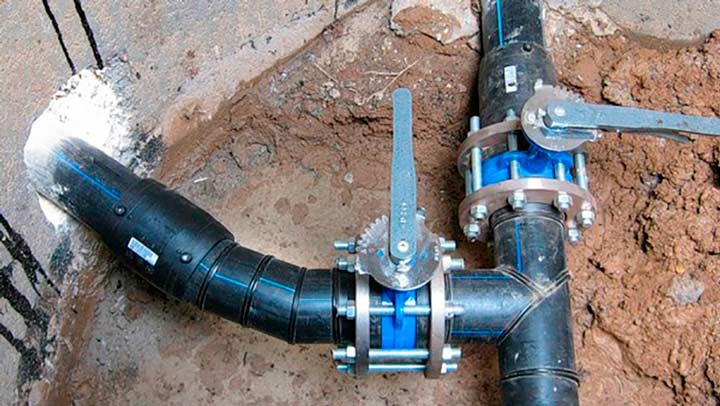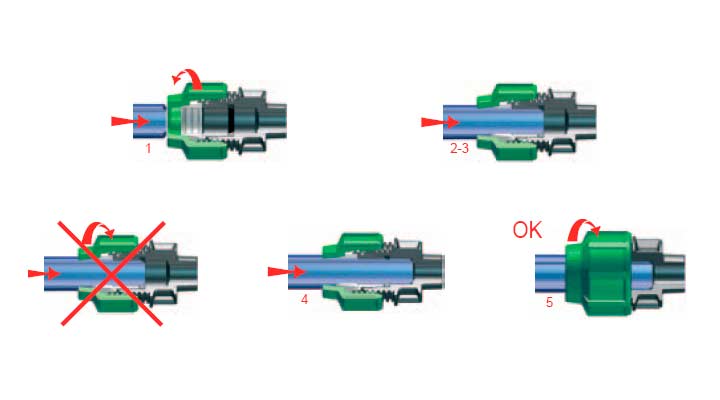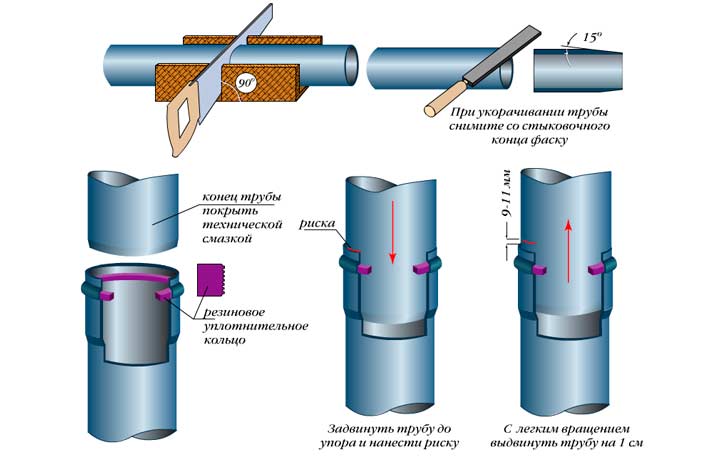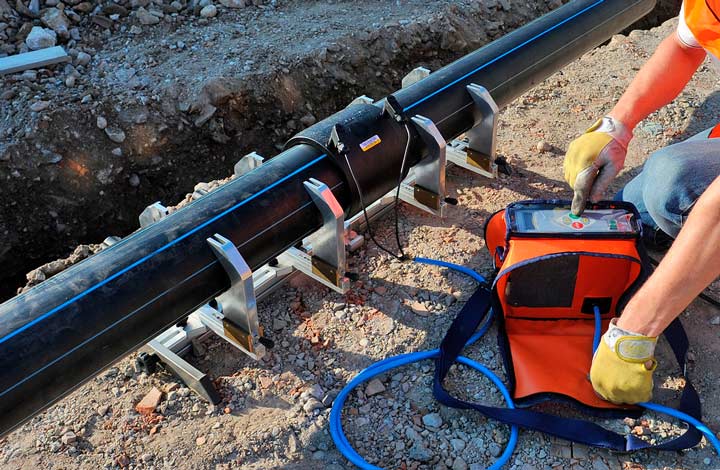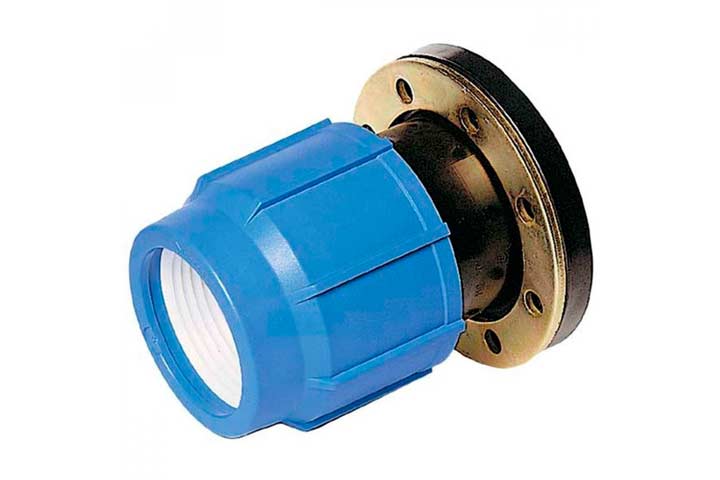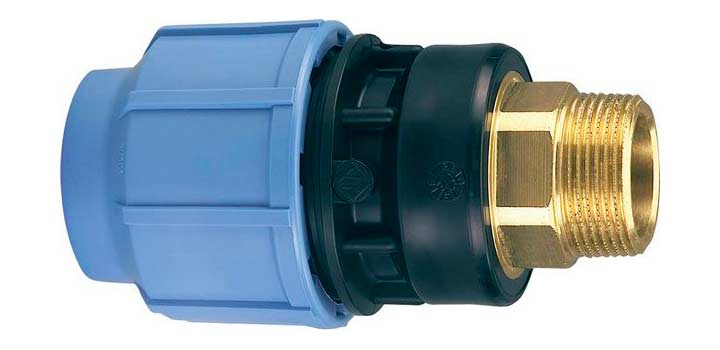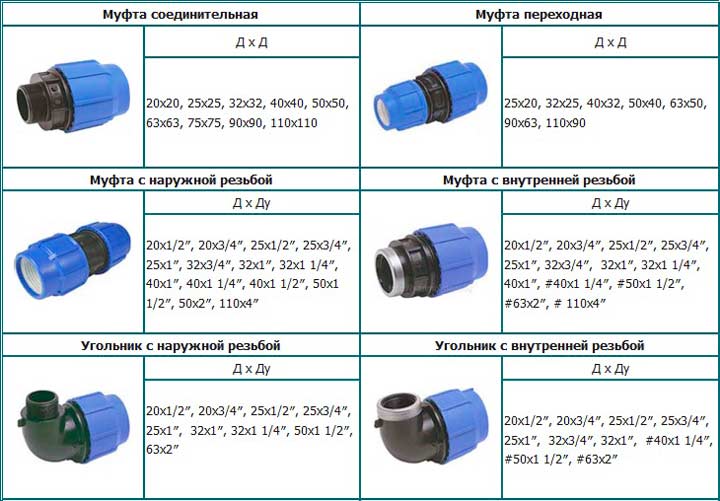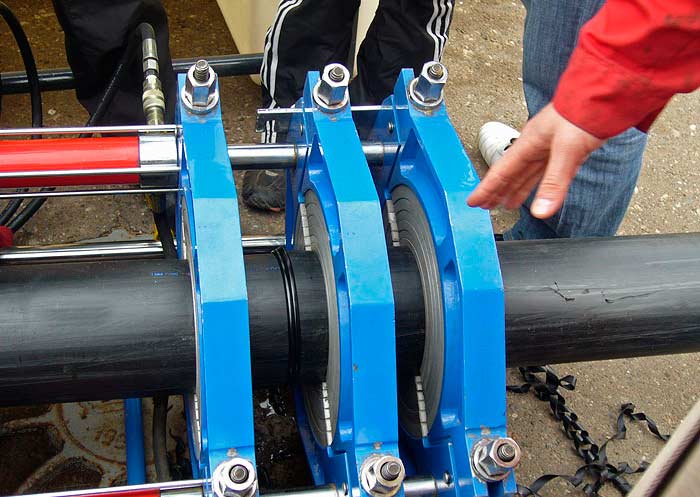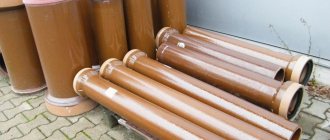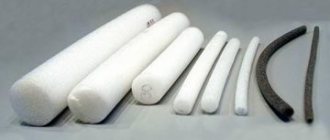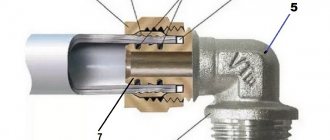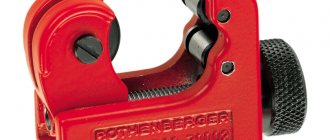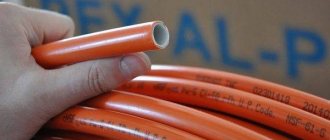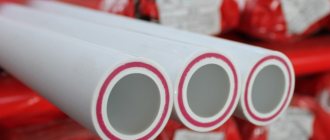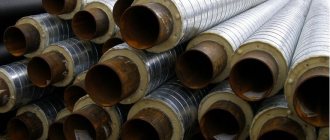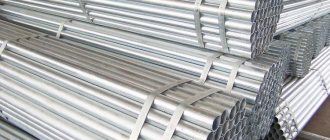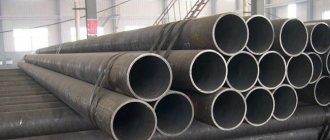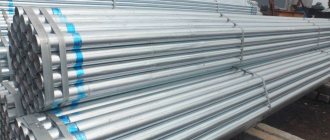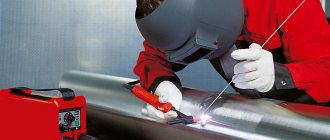Features of the method
A socket is a mounting extension at the end of a pipe. This design allows you to assemble a sealed and durable flow-through interface.
For this, the smooth edge of one pipe is placed in the socket of the other. To achieve tightness, special seals are used. A socket joint with a rubber sealing ring is one of the used methods for installing sewer and water lines.
Pipes are also glued. But in this case, the reliability will depend on the resistance of the adhesive base to water.
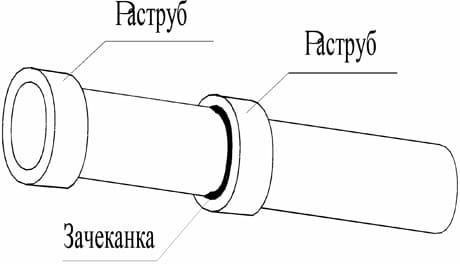
Installation tools and accessories
To install a pipeline using electrofusion fittings, you will need tools:
- for cutting pipes - a pipe cutter or a hacksaw for metal;
- sharp knife + sandpaper or beveller for cleaning the cut from burrs, irregularities;
- acetone or organic solvent, rags for removing dust and degreasing the joint.
The welding process itself requires the supply of a certain current to the terminals. For this, a professional welding transformer is used. It belongs to the expensive special equipment. For the installation of individual communications, such an electricity transformer can be rented.
We recommend that you familiarize yourself with: Tie and methods of connecting elements in the duct
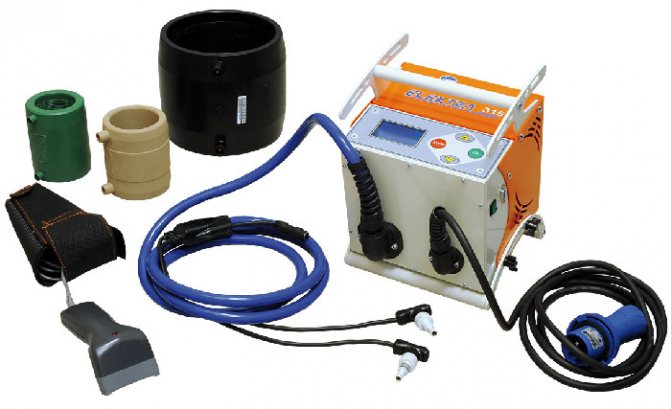

The welding machine can be easily adjusted to the required voltage. In most modern welders for plastic materials, the adjustment is carried out automatically, according to the barcode on the electrofusion fitting. Advanced models read information directly from the coupling terminals.
Flare connection options
Socket pipes can be made of various materials, small or large diameter. Considering these parameters, the most suitable connection options are applied.
Cement filling
This method is most often used for socket connection of cast iron pipes.
- The necessary measurements are made.
- The pipe is cut in such a way that the end face is free of cracks and notches.
- Then the prepared element is inserted into the socket.
- The gap inside it is closed using an oiled sealant (hemp or flax).
- Place the first layer of sealant in the pipe. In this case, the ends of the strands should not fall inside.
- Minify the seal using a hammer and screwdriver.
- Then carefully place the remaining layers of sealing material two-thirds of the depth of the socket.
- The last layer should be applied without impregnation.
- Fill the empty distance to the end of the pipe with cement mortar or asbestos-cement mixture. Also, cement can be replaced with silicone sealant, bituminous mastic or any other similar compound.
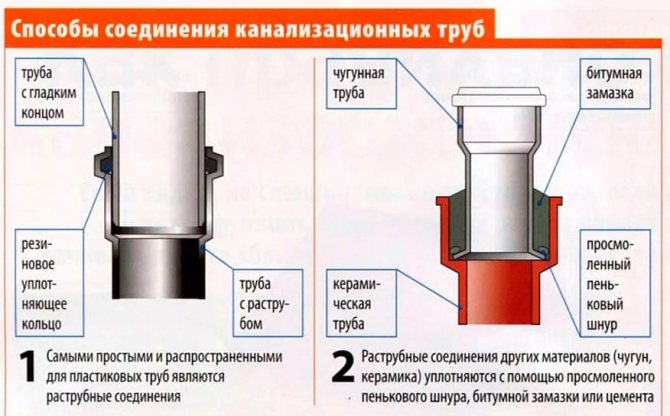

An alternative is another way of assembling cast iron structures. This is the filling of the sockets with expanding cement. Its advantages are:
- waterproofness;
- the ability to expand;
- self-sealing when hardened.
It should also be noted that the use of expanding cement significantly saves time during installation, since there is no need to caulk and stamp the joints.
O-ring application
This is one of the ways to connect plastic pipes. The rubber ring ensures tightness. It is clamped between the straight edge of the pipe and the walls of the socket.
The seal can be with special plastic inserts. But this is optional.
It is important to avoid deformation of the sealing collar on the ring. This can cause leakage in the joint area. Curvature of the axis is allowed, but it should not exceed the thickness of the pipe wall.
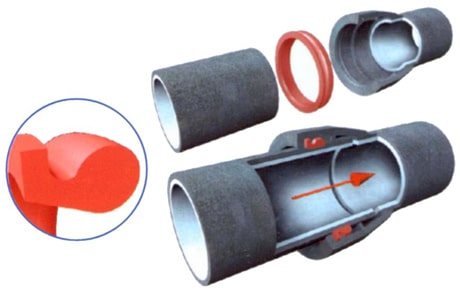

The ring may be damaged during installation. To avoid this, it must be lubricated with glycerin, silicone grease or soap. You cannot use oils for this.
The connection sequence is as follows:
- Clean the rubber ring.
- Place it in the socket groove.
- Lubricate the beveled end of the pipe with glycerin or ordinary soapy water.
- Insert it into the socket up to the mark.
- Check for a ring in the groove. To do this, turn one of the parts to be connected.
In the case of connecting pipes made of different materials, transition pipes are used.
A special tool or a hacksaw is used to cut pipes. Saw strictly perpendicularly, laying the pipe in the miter box. After that, a chamfer is removed from the cut end with a file at an angle of 15 °. This helps prevent damage to the O-ring during installation.
Installation with glue
Glue installation is quite simple. This should be done in the following sequence.
- Prepare pipe ends. Roughen them with a sandpaper.
- Degrease with methylene chloride.
- Prepare a special glue.
- Apply a layer of adhesive to the tapered section of the pipe and to the inner surface of the socket.
- Connect the mating elements and press them together.
- After a while, the glue will harden, providing the necessary tightness.
It is important to know that lateral loads are unacceptable with such a connection. They can break the adhesive layer.
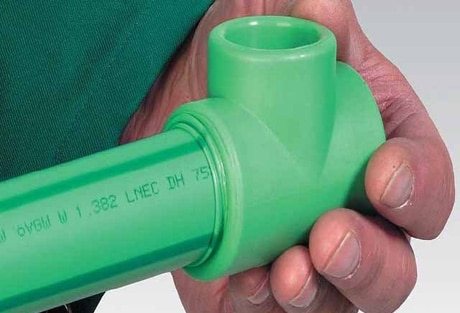

Two formulations of glue are recommended:
- First: perchlorovinyl resin (14-16 parts) and methylene chloride (84-86 parts by weight).
- Second: perchlorovinyl resin (14-16 parts), methylene chloride (74-76 parts) and cyclohexanone (10-12 parts).
It is important to know: open glue is suitable for only 4 hours due to the solvent content in its composition.
contact welding
Socket connection of pipes using resistance welding is a variant of joining parts made of various materials. It can be used for cast iron and steel as well as plastic pipes.
In this case, a manual or mechanical welding machine is used. It must be equipped with special devices for heating the elements to the required temperature.
This is a sleeve with which the outer part of the pipe is heated. And also a mandrel, which is designed to melt the inside of the part.
The sleeve-mandrel set must correspond to the diameter of the assembled structure.
Resistance socket welding is carried out as follows:
- Heat the cell with an electric current or blowtorch.
- At the same time, regulate the temperature using a thermal pencil, thermostat or pipe material - the element should melt, not burn.
- At the edges of the pipe fittings, chamfer 1/3 of the pipe wall thickness at an angle of 45 °.
- Install the stop collar on the plain end at a distance of the socket depth plus 2 mm.
- Insert the mandrel of the heater into the socket, and push the sleeve to the stop on the smooth edge. The heating period will depend on the pipe wall thickness and material.
- Remove the molten parts from the sleeve and the mandrel at the same time.
- Connect together within 2-3 seconds.
- Do not rotate parts relative to each other.
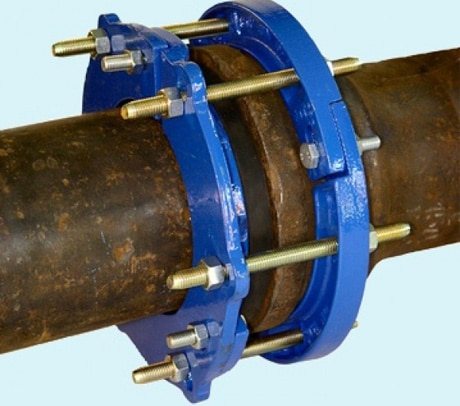

Metal-plastic pipes and features of their installation with a coupling
For joining metal-polymer pipe products, couplings are rarely used. Connectors with fittings of the same diameter on both sides are used for splicing short lengths.
Small-section metal-plastic pipes are sold in coils and purchased in the required quantity. At the same time, one of the types of couplings is in great demand, which is an adapter for pipe threads.If it is necessary to change the liner in the house for metal-plastic products, it is required to update the valve and the pipe following it. And in this case, the use of an adapter is necessary.
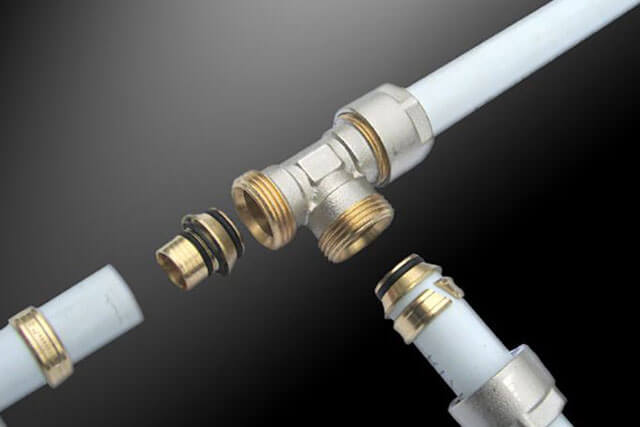

To mount pipe couplings when laying a metal-plastic line, proceed as follows:
- Flax dipped in natural drying oil and covered with red lead is wound onto the external thread, onto which the coupling must be screwed, moving clockwise. Its use is considered the most reliable and durable option for sealing joints. According to experts, the use of flax and any paint is also a good way. The fact is that these non-impregnated natural fibers are hygroscopic and subject to the decay process, and synthetic sealants can be squeezed out under the influence of high pressure.
- The adapter is screwed onto the external thread with little effort, using an open-end wrench or an adjustable wrench, but the pipe wrench leaves scratches.
- Then a union nut and a split ring are strung onto the pipe, and the chamfer is removed from the inside from the pipe surface.
- A pipe is placed on the fitting and then the union nut is tightened, holding the fitting body with another wrench. At the same time, the split ring on the fitting will compress the pipeline and O-rings. The main thing is not to move these rubber rings.
The couplings for connecting pipes must have the same dimensions as for metal-plastic pipe products. The most demanded products are with parameters of 16, 20, 26 and 32 millimeters.
When to apply the re-sealant
An additional seal for the socket joint of cast iron pipes is used in two cases:
- for additional sealing during installation;
- to eliminate leaks arising during operation.
As a result of a violation of the tightness and integrity of the minting, a leak is formed at the pipe joints.
The re-compactor is considered more reliable than chasing. It is suitable for sewerage and water supply networks. Consists of breakable cast iron rings, rubber gasket and long bolts with nuts.
Troubleshooting is carried out without reducing the pressure in the line in any weather.
Appointment
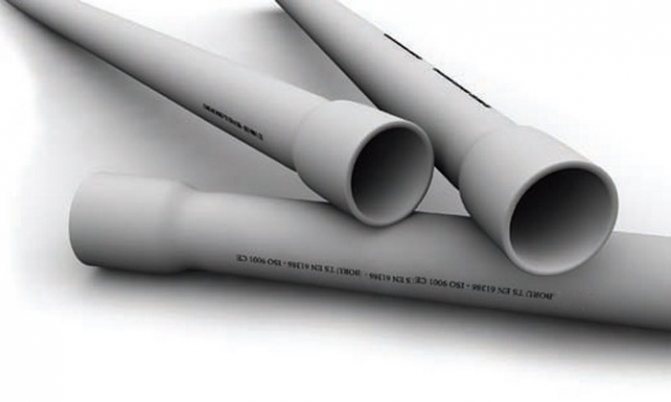

A funnel is a funnel-shaped expansion at one end of a sewer pipe. Thanks to this extension, the pipes can be installed correctly and quickly. As a rule, a socket joint is used on pipes made of:
For asbestos-cement and concrete pipes, such a connection is also sometimes used, but rather rarely. The essence of the installation is that one end of the pipeline is simply inserted into the funnel-shaped expansion at the end of the adjacent pipe. To make the connection tight, additional methods of waterproofing the docking point are used. The choice of this or that method depends on the material from which the pipes are made.
Important: this method of joining pipes is used when installing both external and internal sewage networks.
The main purpose of the socket and the functions assigned to it are as follows:
- With its help, the installation of the pipeline is greatly facilitated and accelerated.
- Leak-proof and leak-tight connection.
- With its help, fittings are connected to pipes.
- Thanks to the socket, elements from different materials can be connected into one system without using fittings.
- When arranging external networks, the bell acts as additional stiffeners, thanks to which the system is protected from deformation and damage.
- When dismantling, the socket connection of pipes makes it possible to do without sawing the elements.
- Flared pipes can not only be quickly assembled, but also dismantled in case of repair or replacement.
Attention: despite such an abundance of functions and advantages, socket structures are not used everywhere. For example, pipelines made of elastic materials are connected according to a different principle.The same is true for some types of pipes made of solid materials.
Plastic pipe coupling
Plastic products are widely used in individual construction and currently completely replace not only steel pipeline communications, but also many types of fittings, and for joining HDPE in everyday life, plastic is the main component.
In a private house, a polymer pipeline made of cross-linked polyethylene and metal-plastic works in heating systems, underfloor heating, hot and cold water supply. Conventional polypropylene and its varieties (fiberglass or aluminum reinforced PP-R) are widely used for heating, supplying hot and cold water to the house.
Internal sewerage is installed from polyvinyl chloride (PVC) polymers, and outdoor sewer pipes (orange) are made from unplasticized polyvinyl chloride (PVCVC).
Plumbing made of low-pressure polyethylene (HDPE pipes) is used to supply cold water to a house; in the industrial industry, polyethylene is a material for outdoor sewer communications, for laying gas communications.
In all the above examples, for domestic use, docking is performed by means of couplings; for soldering polypropylene or installing press fittings, special equipment is required.
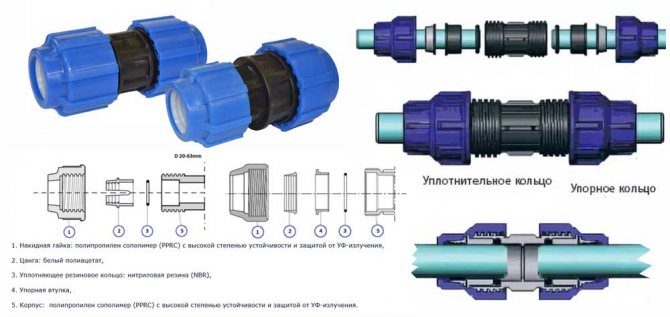

Fig. 5 Compression couplings for HDPE pipes
Compression and press couplings for HDPE and metal-plastic PEX
HDPE pipes are used in the organization of individual water supply, with their help, water is supplied to the house from a well or a well, if the water intake is made by a submersible electric pump or a station located in a caisson.
An integral line is laid underground without breaks, the water supply is connected only at the exit points from the well and the entrance to the house, very often a polyethylene segment is used as a pressure head and connected to an electric pump, leading out of the head of the well.
In all these cases, pipes are connected using plastic fittings, the peculiarities of their installation with a coupling are that they not only connect pipe sections, but also ensure their connection to equipment.
Methods for mounting a pipe with a socket
A pipe with a socket can be metal or polymer, of small and large diameter, designed for a gravity or pressure pipeline. In a word, pipes with an assembly extension (socket) at the end are different, but this vast assortment has one thing in common. Such pipes make it possible to assemble a strong and sealed flow-type interface literally with one movement. To do this, you just need to place the smooth end of one pipe in the socket of the other.
And in this article we will consider a socket connection of pipes made of different materials, supplementing this information with an overview of fittings with an assembly expansion (socket).
Docking of plastic sewer pipes with a coupling
The connection of pipes with a coupling in this case is absolutely the same for all types of plastic sewer system, regardless of the type of material of manufacture.
A sewer system coupling is a short pipe with two sockets and a pair of rubber seals. The peculiarity of the assembly process involves removing the outer chamfers from the pipes and cleaning the inner surface from the existing burrs. If the pipe is not tight enough in the O-ring, a silicone sealant must be used.
Types of socket pipes
The following types of pipes are produced with mounting thickening:
Connecting cast iron pipes with a socket
- Polyvinyl chloride fittings with a diameter of 63 to 315 millimeters (for an O-ring) or 10 to 160 millimeters (for an adhesive joint).The range of such products is determined according to GOST 51613-2000. Moreover, pipes for a rubber sealing ring are used only in free-flow networks, but fittings for a glue socket are recommended for use even in pressure pipelines.
- Cast iron fittings with a diameter of 50 to 150 millimeters. The range of such fittings is standardized in accordance with GOST 6942.0-80. At the same time, the socket connection of cast iron pipes is used not only in the assembly of sewer pipelines. There is another type of cast iron pipes with a socket, the nominal diameter of which ranges from 65 to 1000 millimeters. Such pipes are standardized in accordance with GOST 9583-75 and are used in pressure-type pipelines.
- Ceramic fittings for sewers, with a diameter of 150 to 600 millimeters with a ribbed inner surface of the mounting bulge and the same shoulder of the bell. The range of such pipes is standardized by GOST 286-82
In a word, as you can see, socket pipes can be found anywhere - both underground and above the ground, and in structures, and in oil wells. Therefore, the methods of sealing socket joints simply cannot be of the same type. And further in the text we will consider options for ensuring the tightness of the socket joint.
Retaining ring application
A similar in meaning (prototype) is an option when bell pipes with smooth ends, a retaining ring and a clamping element made in the form of a union nut are connected. The reliability of this installation is due to the alignment of the smooth end of the pipe with the protrusion in the socket.
The smooth end must be forcefully inserted into the socket and fixed using a retaining ring, which in turn is pressed against the socket with a union nut. As a result, the retaining ring with the outer surface of the cone comes into contact with the surface of the cone of the socket at the inlet on one side, and on the other - with the inner surface of the cone of the union nut.
Under the action of axial compression on the conical surfaces, the retaining ring undergoes deformation, as a result of which the protrusions on the inner surface of the retaining ring from the socket side cut into the pipe surface and fix its smooth end with a socket. Also, in the process of radial deformation, the smooth end of the pipe is fixed to the other end of the retaining ring, where specially designed slots are made.
The connection in question has its negative sides:
- complexity;
- insufficient strength under the influence of longitudinal forces and internal pressure of the working medium;
- in addition, the retaining ring is a complex configuration, which adds to the complexity of the installation. Based on the tolerances for the outer diameters of pipeline fittings, the retaining ring is put on the smooth end of the pipe with a gap, from which it follows that plastic deformation of the ring is required both in the area of the projections on the inner surface and along the section to secure the smooth end when screwing on the union nut.
In order to ensure tightness in the socket joint, as noted earlier, the smooth end with an applied force is inserted into the socket, as a result of which the pipe is deformed along the contacting surfaces, but the retaining ring will press the pipe end when the nut is screwed on only when it is deformed in the radial direction , for which it is necessary to apply very great efforts, which are practically unrealistic, especially if pipes of large diameters are installed.
Sealing a flare connection: overview of options
The tightness of the socket joint is ensured by gaskets, adhesive bonding, additional seals and conventional welding. Moreover, the rings (sealing and retaining), as well as the slip flanges, provide for the detachable installation of the socket interface, and the welding and glue assembly - the one-piece assembly option.
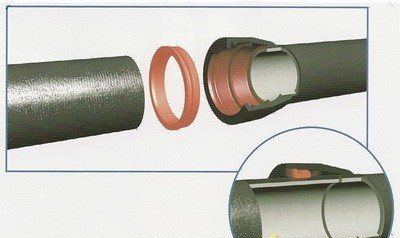

O-ring mounting
Well, the details of these technological processes are as follows:
- Mounting on an O-ring is carried out as follows - an O-ring is placed in the socket, placing it in the inner groove; the smooth end of the pipe is pushed with effort, through the ring, into the bell. As a result, the pipe pushed into the socket expands the ring and wedges in the mounting bulge. True, such a joint will only withstand atmospheric pressure, therefore this technology is used only when assembling sewer or branch pipelines. But such a method of joining will withstand transverse deformations better than other methods of one-piece mounting.
- A special case of mounting on a seal is the fixation of cast iron pipes with tow, driven into the gap between the socket and the pipe. Moreover, after chasing (this is the name of this operation), a layer of bitumen or cement is applied to the end of the socket.
Installation of pipes with a socket on glue
- An analogue of embossing, implemented in polymer pipelines, is installation in a socket using a retaining ring. In this case, a rubber ring is moved to the joint of the pipe and the socket - an additional seal for the socket connection of cast iron pipes, which is made from a flat tape (the excess edges are cut off). Then, on both sides of the socket joint, detachable clamps are mounted, created in the form of segmental washers. By assembling these segmental washers, a semblance of a flat flange can be obtained. And one such "flange" is mounted behind the bell, and the other - end-to-end to the rubber seal. By screwing in the mounting studs of this "flange" connection, the seal ring can be immersed in the gap between the pipe and the socket. And thanks to the elasticity of the additional seal (rubber ring), such a connection will withstand both lateral and longitudinal deformation.
- Glue installation is very simple. The first layer of glue is applied to the tapered section of the pipe, and the second layer of adhesive is applied to the inner surface of the socket. After that, the pipe is inserted into the socket and the mating elements are pressed against each other with considerable effort. After some time, the adhesive layers will harden and the joint will become airtight. True, lateral loads with this method of installation are categorically contraindicated. They can destroy the fragile adhesive bond.
Resistance socket welding is carried out using special devices - soldering irons. The heating element - a tire - of such a device is equipped with low-melting nozzles: a nipple, the diameter of which coincides with the internal dimensions of the socket, and a coupling, the through-hole of which coincides with the external diameter of the pipe.
By heating the corresponding parts of the socket joint of thermoplastic pipes on the nipple and in the sleeve, we achieve the destruction of polymer chains. And by pressing the heated pipe into the same socket, and leaving the connection alone for 10-15 minutes, we create conditions for the emergence of new polymer chains.
As a result, socket welding is the most reliable technology for installing polymer reinforcement.
Types and application
Coupling is a short pipe with a thread inside. If seals are used, tightness of structures is achieved. The material for the manufacture is polyvinyl chloride, which has the following properties:
- does not corrode;
- installation from - 20 to 50 degrees;
- fire resistance;
- durability.
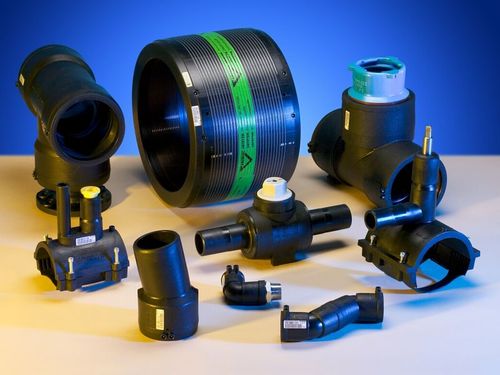

Due to the properties of the material, the coupling is flexible and allows the transport of chemical media. PFor this reason, the connection by fitting is used in the lines:
- sewer;
- heating;
- gas pipelines.
If the plastic pipes are made of low-pressure polyethylene, then their joining is solved by such a design. Installation is simple: plastic pipes are inserted into special bushings, after putting on nuts on them: a clamp and a cover.
It is also allowed to connect with other structural parts. Depending on their application, there is a division into types:
- Connecting. They are used for tight connection of pipes into a single line. They allow you to quickly carry out repairs and troubleshoot in case of an accident.
- Protective. Installed during repairs on damaged areas. There are types: electric and crimp (compression).
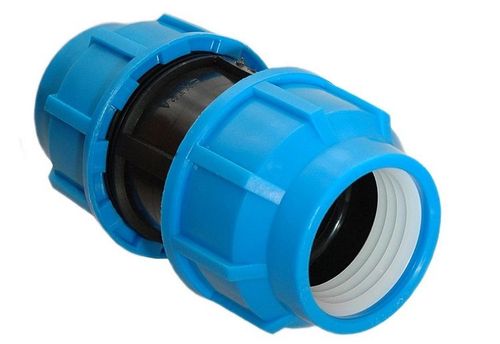

Depending on the material of the water supply pipes, the connecting part differs in design and application.
Socket pipes: purpose, types, practice of application
Socket pipes are widely used in industry, urban planning facilities, where it is required to organize pipeline systems for various purposes. In modern construction, it is very important to arrange the so-called zero cycle - the foundation that prepares the site for installation work on the construction of the facility. At this stage, the construction of underground utilities is not complete without the use of structures such as a bell pipe.
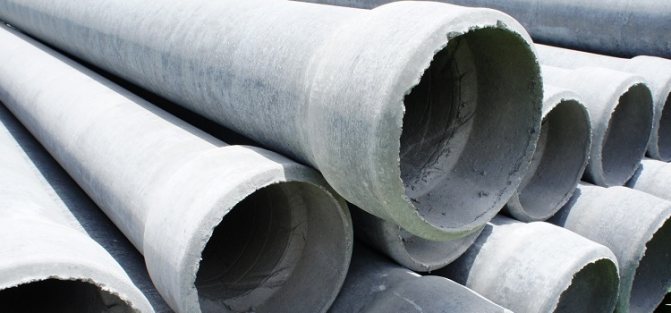

Pipes with a socket make it possible in the shortest possible time to install highways for various purposes
Areas of use for socket pipes
Transportation of liquids, sewerage, stormwater system is impossible without the use of a special type of pipes. The socket design is reliable and easy to use, relatively inexpensive to manufacture and practical to operate. Its use is ubiquitous:
- industrial and civil construction;
- hydraulic engineering works in various directions;
- road construction;
- construction of railway facilities and tracks;
- Agriculture.
Pipe structures are made from various materials. The main ones that have become firmly established in the practice of application are concrete, cast iron and plastic. Each of the types has its own advantages and disadvantages. The technical characteristics of these products determine the scope of their application.
Types of socket pipes, their quality characteristics
A pipe with a bell, besides all other advantages, has the main advantage - ease of installation, manufacturability in operation, relatively low costs for the installation of products.
Concrete products are especially popular. Their cost becomes lower as the produced pipe diameter increases. The bell system itself is very practical. An extension is formed at one end of the pipe, which serves as a seat for the other pipe. The joint is sealed in a manner that is most effective for this type of product.
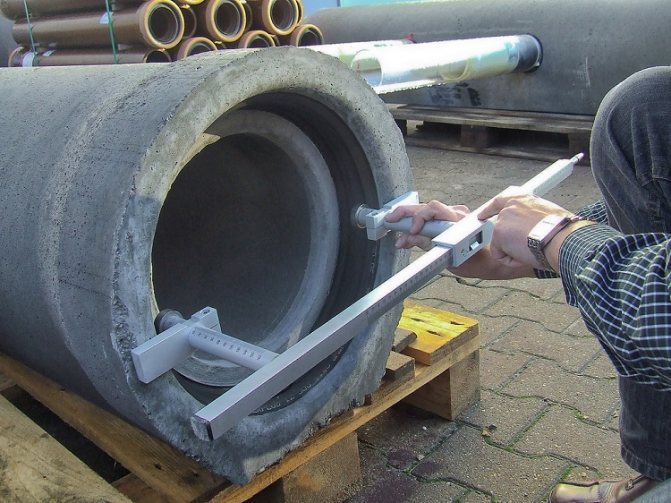

Bell-shaped products have an extension at the end, into which the edge of the subsequent pipe is inserted
Concrete and cast-iron pipe connections are coined with sealing concrete and resin compounds with a filler, and plastic ones - with rubber O-rings that fix the installation connection. For concrete and cast iron products, special rubber seals can also be used. They improve the tightness of the connection, making them moisture-proof.
Note! The sockets in the piping system are located against the direction of fluid movement.
As a rule, cast iron and plastic socket systems are installed for sewerage and other indoor systems. Concrete products are most often used in external sewer or drainage collectors. Large diameters are usually required there, capable of freely carrying bulk liquid masses.
Socketless pipes, their connection, principles of use
Socketless pipes are also popular and practical to use, install and operate. The fundamental difference from the socket versions is that the pipes are assembled with the help of additional devices that ensure the connection and sealing of the joint.
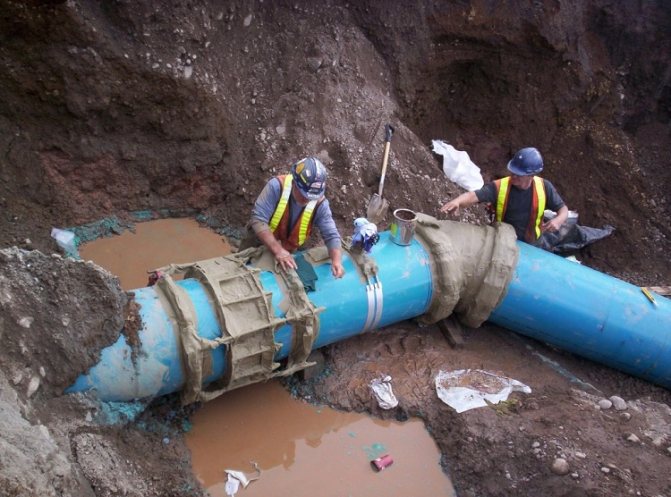

Socketless pipes are connected using couplings, collars and other fittings
For reinforced concrete structures, a concrete flange serves as such a connecting element, and a clamp for cast iron pipes. The absence of a socket in some cases simplifies the installation of the pipeline, reduces the construction time. Basically, such products are used in the construction of non-pressure systems. But, using special cuffs that increase the degree of sealing and strength, pipelines can perform the functions of pressure, that is, keep the pressure of the internal environment. The main application of such products is drainage or socketless sewage.
Design features
Electric-welded coupling for polyethylene pipes is a cylinder made of low-pressure polyethylene. The inner diameter of the coupling is slightly larger than the outer dimensions of the pipes to be connected. Electric-welded coupling PND 100 is designed to connect straight sections of a polyethylene pipeline of the same diameter.
Manufacturers offer a size range of welding fittings from 20 mm in diameter to 900 mm. The length of a small fitting depends on its diameter in a ratio of 1: 2.5. For example, an electrofusion sleeve for pipes with a diameter of 20 mm will be 50 mm long. The length of the maximum diameter welding fitting is slightly larger than its values. So a coupling with a diameter of 800 mm has a length of 90 cm. The length of a coupling for 900 mm is 1 m. Manufacturers offer electric-welded couplings with an elongated body.
We recommend that you familiarize yourself with: How to choose and install ventilation clamps for attaching air ducts
Inside the fitting there are electric heating coils, the contacts of which are brought out in the form of terminals. The material and location of the heating elements of the electrofusion sleeve prevent heat from spreading to the outside of the part.
The welding process is provided by melting polyethylene under the influence of temperature. The molecular diffusion process affects the inner surface of the sleeve and the outer wall of the pipes. Polyethylene is melted to a specific depth and mixed at the molecular level. When solidified, a monolithic formation is formed, which has no visible interface.
The part can be equipped with a welding progress indicator. This allows you to track the connection process and simplifies the work. Fasteners on the electrowelded sleeve allow you to securely fix the part on the pipes, which eliminates rejects at the joint.
The fitting has a special barcode on the tag, which is read by the scanner of the welding machine. According to the barcode information, the device sets the heating time and temperature to obtain a perfect joint.
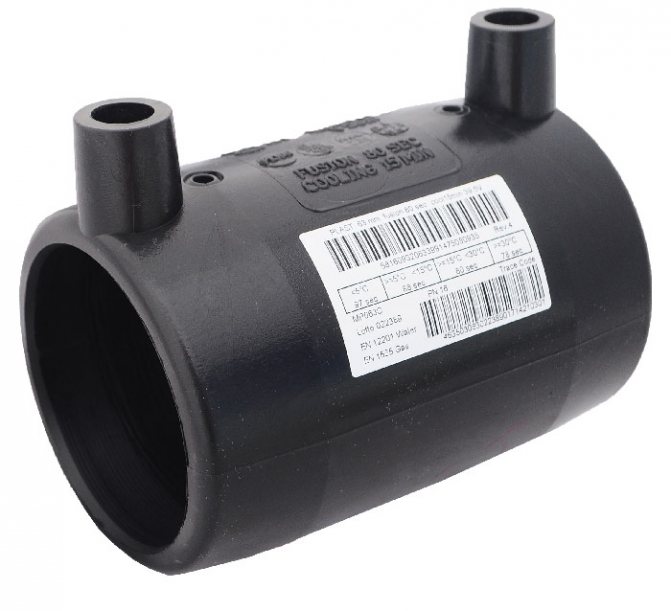

Since the welding process is provided by molecular diffusion of molten polymer, the composition of low-pressure polyethylene in the body of the electrofusion sleeve is of great importance. The overwhelming majority of fittings are made of polyethylene of grade 100, but there are also couplings of 80. Fittings of grade 100 are considered universal. They are allowed to be used for any HDPE pipes.
Note! For a high-quality connection of HDPE pipes with electrowelded couplings, purchase pipe material and fittings from one manufacturer. This will ensure the complete affinity of the polymers.
Assortment of concrete products. Manufacturing features
Concrete socket pipes are used in civil and industrial construction. They are inexpensive, practical, durable in use. Most often they are used in the construction of sewerage systems, urban stormwater systems, bypass pipelines for water in road construction. According to their purpose, reinforced concrete products are divided into:
- free-flow;
- pressure head;
- designed for all types of road construction.
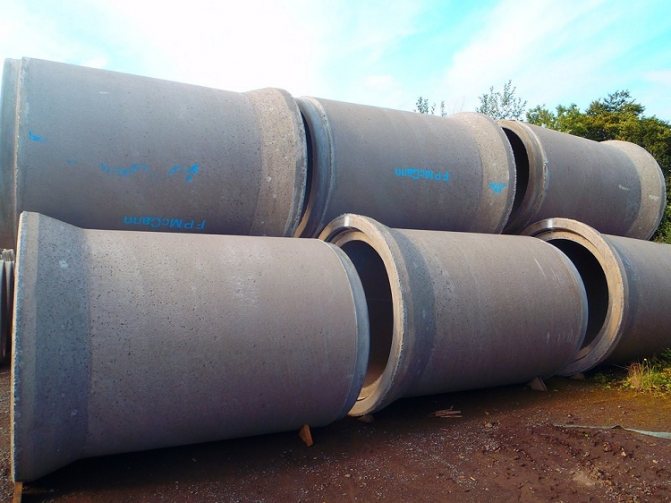

Socket pipes made of concrete are of the pressure and non-pressure type
The industry produces three main types of socket pipes: type T, type TB and type TV. They differ in the method of production, load characteristics, and other special parameters provided for by GOSTs.
Reinforced concrete gravity pipes of type T are used for laying sewer systems, drainage systems for ground and underground waters, and other non-aggressive liquids for this product. They can withstand significant loads, are inexpensive in terms of manufacturing cost, and include available materials.
The TB type is capable of carrying an increased load during operation. They can be supplied with rubber O-rings, which simplify the installation of the connections, making them tight.
Important! Such pipelines can be used as pressure pipelines for pumping water and other liquids that are neutral to the concrete composition.
For example: the most used pipe dimensions are socket products 5 m long, 1 m in diameter and 75 mm thick. They are optimal from the point of view of the construction of the sewer collector, make up a convenient load for transportation by car - 5 pieces each on a specialized platform.
Pipes of the TV type are intended for use in road construction. These are especially durable products, complete with O-rings, capable of withstanding the pressure of the soil layers and the work of the road deck for a long time. They are divided into four groups according to their bearing characteristics:
- Group 1 - the ability to bear the pressure of the backfill soil and the roadbed up to 5 meters thick;
- Group 2 - load capacity up to 10 meters;
- Group 3 - load capacity up to 15 meters;
- Group 4 - up to 20 meters of backfill thickness.
Flared sewer concrete pipe is a rigid and reliable structure with a service life of more than 50 years. This is what makes it a special technology of using durable concrete, special structural reinforcement and high-tech manufacturing methods. The price-quality ratio of this structure is optimal, therefore, most design and construction organizations, when looking for the necessary pipes for organizing the construction of hydraulic systems, opt for concrete products.
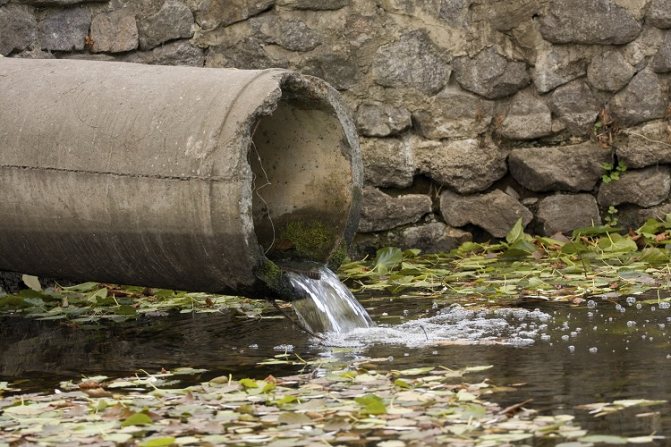

Concrete pipes with and without socket are most often used in drainage and sewerage systems
Cast iron and plastic socket systems
The use of cast iron and plastic flared pipelines has long been rooted in construction practice. The cast iron pipe is a long-standing structure that provides a drainage system, drainage. Even in our very technological time, it is often applicable for the same purposes. Both cast iron and plastic are used in internal drainage structures and sewage systems.
A cast iron pipe is often used as a reliable protection for cable networks when laying them underground. It protects the contents from moisture and mechanical stress, is not subject to combustion. When protection from the cold is required, a special insulation is used. One of the disadvantages of a cast iron pipe is its susceptibility to corrosion. For long-term operation of such a pipeline, corrosion-resistant insulation is required.
Recently, socket types of plastic pipes have been widely used. They are very practical, lightweight and have almost the same characteristics as cast iron pipes, except for mechanical stability. In their manufacture, polypropylene, polyvinyl chloride, high or low pressure polyethylene are used.
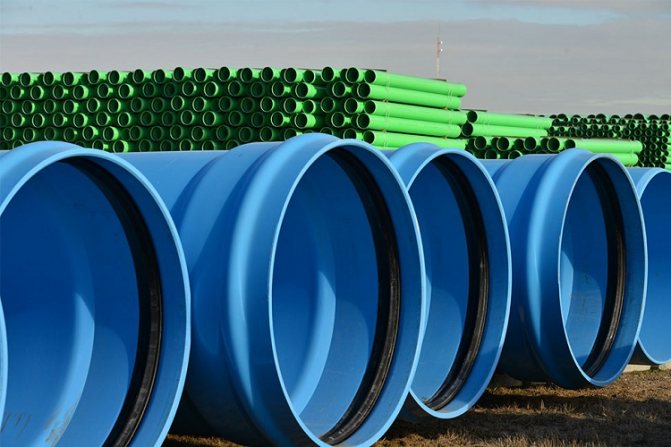

Polymer pipes are completed with rubber bands in the socket, which greatly simplifies and speeds up their installation
The scope of application of these pipes is the same as that of traditional cast iron or concrete structures. The difference is in the technological capabilities of the pipe material.Modern fixation of the socket joint is carried out using a rubber O-ring, which ensures the sealing of the joint. Welding connection is also possible. The multicolored design gives the pipes an aesthetic appearance and indicates its purpose in the piping system. One of the important advantages is that plastic systems are not susceptible to corrosion.
Installation tips
Installation of sewer systems is structurally not difficult, the main thing is not to forget that there is a gasket in the socket, and even lubricate the gasket with silicone.
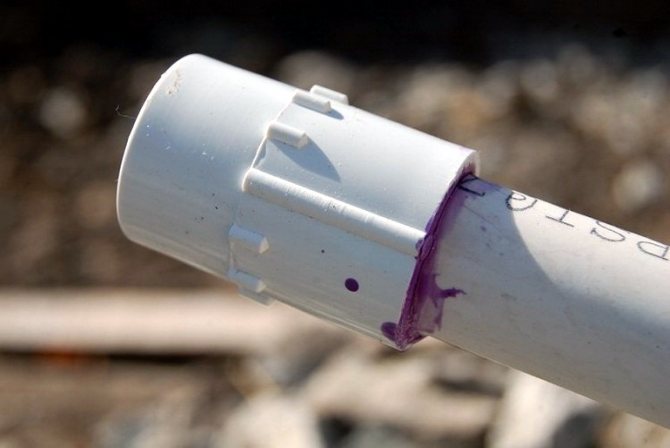

When laying domestic cold water supply systems, "cold welding" is most often used.
Required tools and materials
You will need a grinder with cutting discs, glue, a file, rags, alcohol (denatured alcohol can be used), a coupling, pipes.
Welding technology
"Cold welding" of pressure water supply systems is carried out using a special adhesive for PVC. The technology is quite trivial: to lubricate the surfaces to be joined, to connect, to withstand.
Work order
When joining pipelines using bushings, there are some peculiarities, below is a step-by-step sequence of work execution:
- the ends of the pipes to be connected are cut exactly perpendicularly, they are cleaned with a file from burrs. They are cleaned of dust and shavings with a rag. It is advisable to remove small chamfers;
- insert pipes into the coupling until they stop, mark with a risk the depth to which the pipe is inserted into the fitting;
- disassemble the unit, degrease the pipes and fitting;
- With a clean brush, apply special glue to one branch pipe on the outside and the corresponding inner surface of the fitting. The glue should be applied quickly and immediately, while the glue has not dried, insert the pipe into the sleeve, fix in this state for 20-30 seconds. Then you should leave the connection for 10 minutes (if the air temperature is at least 10 ° C) - until firm adhesion. From the moment the glue starts to be applied to the moment the assembly is fixed, no more than 20-25 seconds should pass, otherwise the glue will begin to solidify and the quality of the welding will deteriorate;
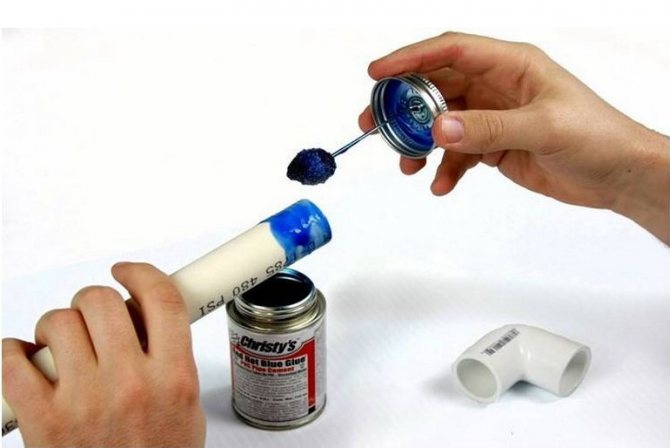

- then they coat the second side of the fitting and the second branch pipe, connect, hold;
- it is necessary to control the depth of pipe penetration into the fitting - it must be inserted into the coupling up to the mark made;
- if the connection is done correctly, a thin strip of protruding glue will appear at the junction - it must be wiped off with a rag;
- it is advisable to fix the mounted section in the mountings and leave it for a day;
- it is necessary to ensure that the glue does not have time to dry on the surfaces to be joined. Dried glue glues surfaces less reliably;
- the system can be filled with water and tested no earlier than 24 hours after welding.
Our video shows the pipe welding process in all its subtleties:
Practical application of socket pipes
Socket products are widely used for organizing pipeline systems designed to transport liquids in the pressure and non-pressure modes of use. Reinforced concrete structures of large diameter are used for sewerage, drainage of rainwater from city streets. Cast iron and plastic systems have the same purpose, only, mainly, inside buildings, structures, various civil objects, private estates.
Pipelines are used as protective transport systems for wiring cables, routing heating and other types of technological networks. Almost all types of socket pipes can withstand a wide range of temperatures and pressures of surface earth masses. Well-sealed structures provide the required internal pressure of the liquid composition transported through the pipeline.

